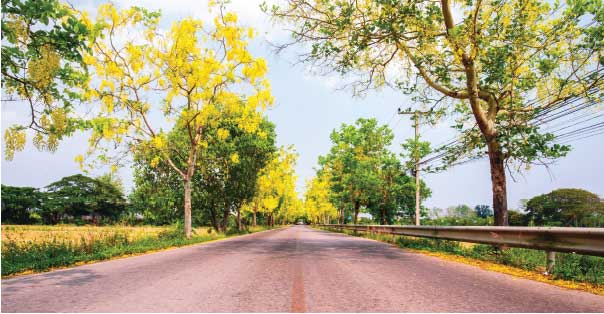I’m writing this a week after Memorial Day and we just had our first rain (luckily not wind) event of the season—13 inches of rain in Miami in 24 hours over the weekend. It’s amazing how 90% of the time it seems we have gorgeous blue skies and sun and then every once in a while nature turns ferocious. Of course it’s not just the sunny weather, it’s all the beautiful flowers. Right now it’s the Royal Poinciana trees and the Golden Shower (cassia fistula) trees with their clusters of hanging yellow flowers like grapes.
 WOW, get the hot orange Royal Poinciana flowers next to a Golden Shower flowers and it’s a magnificent sight! Actually, I love this time of year—I’d like the three months of summer to be six months long!
WOW, get the hot orange Royal Poinciana flowers next to a Golden Shower flowers and it’s a magnificent sight! Actually, I love this time of year—I’d like the three months of summer to be six months long!
Energy Efficiency Guru Thinks This May Be a Turning Point
Amory Lovins, nicknamed the “Einstein of energy efficiency”, an adjunct professor of civil and environmental engineering at Stanford University, has been one of the leading advocates and innovators of energy conservation for 50 years. Lovins is arguing for the mass insulation of buildings alongside a vast acceleration of renewables.
He says, “Solar and wind are now the cheapest bulk power sources in 91% of the world!!!!!” What he is talking about is changing the design logic for buildings. He personally lives in the Snow Mass ski resort in a house he designed to collect energy and to need no heating which saves 99% of the energy to heat water and the house, and 90% of the electricity. (The Guardian 3/26/22) Temperatures dropped below freezing that night but Dr. Lovins is growing bananas and other tropical fruit in his house.
So the basic idea is to wrap the structure in insulation like a tea cosy, then install a heat pump core for the mechanicals and add a super-insulated solar roof. As of now his ideas have mostly been adopted by businesses. For example, Walmart, the worlds largest truck operator, has improved its energy efficiency-NEARLY 40%–by rethinking its operation.
He says “In our house we save 97% of the pumping energy by properly laying out some pipes. In turns out that far less energy is need to pump heat or cold through fat, straight pipes than skinny, long crooked ones because there is less friction.” Man this is basic common sense stuff when you think of it. I sure hope we get going on some of it.
He says that in 2020 the world added 0.4 gigawatts of nuclear capacity and 278 gigawatts of renewables… Why aren’t we hearing more about this, I wonder, and doing more along these lines?
Some Kind of Wonderful
 I had a generator installed in my side yard and my cherry hedge in front had to disappear for the machine to get in so I now have a fence there. I got some vines from Fairchild and others to climb on the fence, including stephanotis and honeysuckle. One of the Fairchild vines, Barbados Gooseberry (pereskia aculeata) has just bloomed for the first time. Beautiful creamy white scented flowers all over the vine! And the first white ginger blooms of the year in my yard. Oh, and let’s not forget the frangipani. I do love nature and scented flowers!
I had a generator installed in my side yard and my cherry hedge in front had to disappear for the machine to get in so I now have a fence there. I got some vines from Fairchild and others to climb on the fence, including stephanotis and honeysuckle. One of the Fairchild vines, Barbados Gooseberry (pereskia aculeata) has just bloomed for the first time. Beautiful creamy white scented flowers all over the vine! And the first white ginger blooms of the year in my yard. Oh, and let’s not forget the frangipani. I do love nature and scented flowers!
“There is so Much Intelligence on this Planet. Realizing this will be Key to Adapting to Climate Breakdown,” – James Bridle
Scientists are experimenting with plants known as “hyperaccumulators”. These are plants that have evolved the capacity to thrive in naturally metal-rich soils that are toxic to most other kinds of life. They do this by drawing the metal out of the ground and storing it in their leaves and stems—where it can be harvested like any other crop!!!
The beyond cool thing about these plants, these accumulators, in addition to be a source of metals like nickel, zinc, aluminum, cadmium and many other metals these plants actively benefit the earth by taking the metals out and making the soil suitable for growing other crops.
So the reality is that these plants by virtue of their close association with the soil, climate and ecosystem in which they emerged embody a certain kind of knowledge.
Hyperaccummulators are not the only non-humans we can learn from. It turns out that slime molds which are creatures between fungi and amoebae are very good at solving hard mathematical problems. They can solve for say the shortest route between multiple places, “the traveling salesman” problem, faster and more efficiently than any super computer we have devised.
These are just some examples of the “intelligence” in plant and animals. Dogs and other animals have been shown to predict earthquakes in advance of tremors. Plants, it turns, out can hear and remember!!! In one experiment they demonstrated the ability to respond with chemical defenses to the particular sound of caterpillars munching on their leaves—even if it was only a tape recording!
OH PLEASE CAN WE START TREATING THE WONDERFUL WORLD OF NATURE WITH MORE REVERENCE AND LESS HUBRIS???
About the Author

Linda Lawrence Waldron currently writes the Green Gables column in Gables Living Magazine. Linda was Chairman of the Garden Club's Coral Gables Library Butterfly Garden Committee.
Sign up here for email notifications about new Green Gables articles!
More from our blogs
See all postsRecent Posts
- April 2023 April 1, 2024
- Good News on Environmental Plastics February 1, 2024
- Material World / Plant World January 1, 2024
Leave a Comment cancel
This site uses Akismet to reduce spam. Learn how your comment data is processed.









